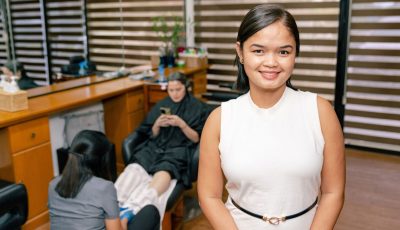Saipan at a glance
I froze my butt in China’s Dong Bei for the last three months, so I am pleased to bring out the short pants, the cotton shirts, rubber sandals, and walk the sidewalks of Garapan and Gualo Rai for a week. Wearing shoes was not typhoon friendly as a low depression threatened from the southeast, bringing rain and wind. With the uneven conditions of sidewalks, I joined the visiting tourists in wearing comfortable rubber thongs.
While roaming, I met former student Nikka who now works at Kanoa Resort, a few inches taller than she was when she sat in my sixth grade class at SVES. Mary Deala was a teeny-bopper when I left, now in Tony Stearns’ clinic reception desk. She and Judith located my spondylosis diagnosis. Dr. Stearns is a walking example of physical fitness that he promotes.
Jun at Volcano’s Bar tried to help locate a friend from Sichuan. I was not able to locate her as the one with similar physical attributes and nom-la-nuit turned out to be from Pea Eye rather than the foothills of the Himalayas. Deedee whose magical fingers and kneading once relieved me of body aches was nicely coiffed, selling cosmetics at the Galleria. Joe Hill, one of our prominent lawyers, munched his French fries at a fast food service by Beach Road. We exchanged friendly greetings; of my age, he chuckled at my article on retire and re-tire.
Another acquaintance, originally from Jilin in Manchuria, who left her countryside home and took on the only trade she could make at a tender age of 14, moved her assets to Saipan at 17 to the lucrative business of leasing out her fleshy charms by the hour. At 20, our nuer (girl, female, woman in Putunghua) wanted to avail of a green card by entering into a jia (fake) marriage with a Chamorro gentleman who let her pay for the cost of USCIS processing plus occasionally enjoying the pleasures of her embrace. USCIS denied the petition, dubbing the application as not bona-fide wedded-ness. Divorced, she entered into real matrimony and moved in with the guy, who suffers from a terminal case of cancer. She cares for him and also staffs his fish stand, and that’s how I caught up with her on this visit. Unfortunately, with her USCIS record, the second petition was also denied. An appeal is on its way, probably hopeless.
Lawyer friends Maya and Bruce over lunch related similar cases with immigration before and after the feds took over. The duo gave knowing grins of approval at a new addition to the island’s USCIS staff. Two mothers, one at a restaurant and the other at a hotel, greeted me by name, reminding me that I was their child’s teacher at 6th grade. The folks at NMPASI have been comrade-in-arms among the differently-abled. I mention all these names to remind me that I may not have been too successful in my paper work closures, but I sure ran into many of my old friends and acquaintances.
As for Saipan itself, with the amount of rain that drenches Saipan, I was surprised that not more houses and buildings were equipped with rain catchment systems. I kept nine three-feet tall empty plastic containers lined and connected to each other in Majuro, retaining the rain from the roof. The water filtered itself from one container to the other, and by the time it got to the ninth can, it’s contents poured into my kitchen tub where I processed the cooking and drinking waters.
Reverse osmosis on sea and ground water has made the 5-gallon bottle ubiquitous on Saipan. The 330 ml bottle, which visiting tourists patronize, easily costs a buck at the mom-and-pop stores. Tap water is a major municipal concern. It is time to design ways to hold, or, perhaps, filter, the fresh water in Lake Susupe, or build a reservoir up Mt. Tapochao.
The other obvious need where innovation and creativity can be gained is energy and power. To see the wind turbines spinning at Garapan Elementary School delighted us. Generating power is one of those that uses strategic planning, plotting operating vision down to practical implementation. The islands are blessed with solar and wind energy it can harness. Most immediately, architectural innovations can use passive solar energy and rain catchment. We can appropriate known technologies of making photovoltaic cells to catch and convert rays into stored power for lights, air-conditioning, or heating water. Wind turbines serve many functions.
We can get sophisticated with tidal turbines along the shores, or use the temperature differences of ocean depth at the Marianas Trench. The Marianas can be a research center to some of these technologies if we can get the local government and the feds to agree on the endeavors, or at least stop squabbling as if they belonged to separate teams. Heavy water (hydrogen) might even be sitting at the bottom of the Trench, a clean source of energy.
There’s also kaong palms, the ornamental plants on island. They are a biofuel source.
We are islands in the sun. We can be an idyllic location full of technological innovations, if we so choose. Why don’t we?
Jaime Vergara previously taught at SVES in the CNMI. A peripatetic pedagogue, he last taught in China but makes Honolulu, Shenyang, and Saipan home. He can be reached at pinoypanda2031@aol.com.



























